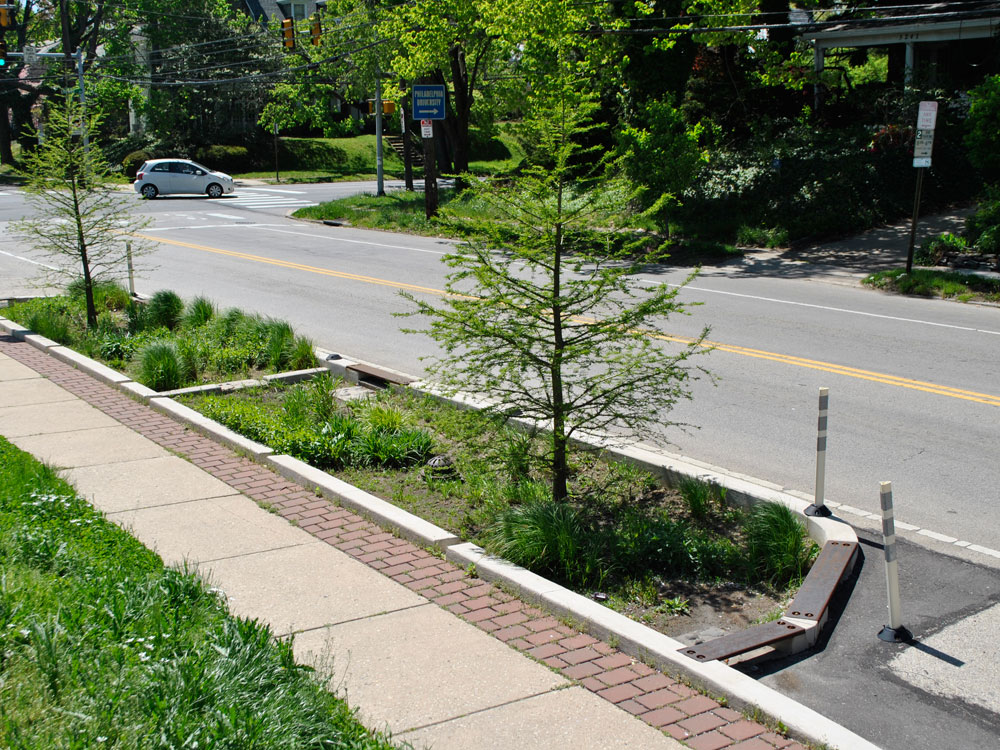Queen Lane Water Treatment Plant

The Queen Lane Water Treatment Plant treats an average of 70 million gallons of water a day. The treatment of drinking water is an extracting process and this plant takes a number of precautions to make sure it is done right. Queen Lane operates 24 hours a day. Every three hours, they test the water at each stage of treatment. These tests allow the plant operators, on staff 24 hours a day, to adjust their treatment to varying conditions (weather and upstream treatment can affect the quality of the water before we get it). Chemists at Queen Lane perform more than 350,000 tests annually to ensure process control. Queen Lane has about a day’s storage capacity without pumping from the rivers.
A stormwater bump-out is a vegetated curb extension that protrudes into the street either mid-block or at an intersection, creating a new curb some distance from the existing curb.
A stormwater bump-out is composed of a layer of stone that is topped with soil and plants. An inlet or curb-cut directs runoff into the bump-out structure where it can be stored, infiltrated, and taken up by the plants. Excess runoff is permitted to leave the system and flow to an existing inlet.
Aside from managing stormwater, bump-outs also help with traffic-calming, and when located at crosswalks, they provide a pedestrian safety benefit by reducing the street crossing distance.
A downspout planter is a structure that is designed to allow stormwater from roof gutters to flow through and be used by the plants. Downspout planters are filled with gravel, soil, vegetation and are connected to the roof downspout to let water flow in. They temporarily store stormwater runoff on top of the soil and filter sediment and pollutants as water infiltrates down through the planter. Excess water can overflow into the existing downspout connection.

The Queen Lane Water Treatment Plant treats an average of 70 million gallons of water a day. The treatment of drinking water is an extracting process and this plant takes a number of precautions to make sure it is done right. Queen Lane operates 24 hours a day. Every three hours, they test the water at each stage of treatment. These tests allow the plant operators, on staff 24 hours a day, to adjust their treatment to varying conditions (weather and upstream treatment can affect the quality of the water before we get it). Chemists at Queen Lane perform more than 350,000 tests annually to ensure process control. Queen Lane has about a day’s storage capacity without pumping from the rivers.
A stormwater bump-out is a vegetated curb extension that protrudes into the street either mid-block or at an intersection, creating a new curb some distance from the existing curb.
A stormwater bump-out is composed of a layer of stone that is topped with soil and plants. An inlet or curb-cut directs runoff into the bump-out structure where it can be stored, infiltrated, and taken up by the plants. Excess runoff is permitted to leave the system and flow to an existing inlet.
Aside from managing stormwater, bump-outs also help with traffic-calming, and when located at crosswalks, they provide a pedestrian safety benefit by reducing the street crossing distance.
A downspout planter is a structure that is designed to allow stormwater from roof gutters to flow through and be used by the plants. Downspout planters are filled with gravel, soil, vegetation and are connected to the roof downspout to let water flow in. They temporarily store stormwater runoff on top of the soil and filter sediment and pollutants as water infiltrates down through the planter. Excess water can overflow into the existing downspout connection.

The Queen Lane Water Treatment Plant treats an average of 70 million gallons of water a day. The treatment of drinking water is an extracting process and this plant takes a number of precautions to make sure it is done right. Queen Lane operates 24 hours a day. Every three hours, they test the water at each stage of treatment. These tests allow the plant operators, on staff 24 hours a day, to adjust their treatment to varying conditions (weather and upstream treatment can affect the quality of the water before we get it). Chemists at Queen Lane perform more than 350,000 tests annually to ensure process control. Queen Lane has about a day’s storage capacity without pumping from the rivers.
A stormwater bump-out is a vegetated curb extension that protrudes into the street either mid-block or at an intersection, creating a new curb some distance from the existing curb.
A stormwater bump-out is composed of a layer of stone that is topped with soil and plants. An inlet or curb-cut directs runoff into the bump-out structure where it can be stored, infiltrated, and taken up by the plants. Excess runoff is permitted to leave the system and flow to an existing inlet.
Aside from managing stormwater, bump-outs also help with traffic-calming, and when located at crosswalks, they provide a pedestrian safety benefit by reducing the street crossing distance.
A downspout planter is a structure that is designed to allow stormwater from roof gutters to flow through and be used by the plants. Downspout planters are filled with gravel, soil, vegetation and are connected to the roof downspout to let water flow in. They temporarily store stormwater runoff on top of the soil and filter sediment and pollutants as water infiltrates down through the planter. Excess water can overflow into the existing downspout connection.